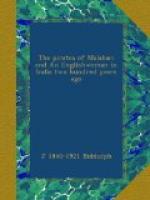Toolajee had now become very powerful. From Cutch to Cochin his vessels swept the coast in greater numbers than Conajee had ever shown, and cruised defiantly off Bombay harbour. But for the presence of four King’s ships on the coast, Bombay trade would have suffered severely. When Boscawen left Indian waters,[3] after receiving over Madras from the French, he detached four ships, the Vigilant, Tartar_, Ruby, and Syren, to cruise on the West coast, under Commodore Lisle. For two years, the protection afforded by Lisle’s squadron gave some security to the Bombay coast trade. As the small sailing boats, in which the coast trade was carried on, made their way under convoy of the King’s ships, Angria’s squadrons hovered round to pick up stragglers, and several slight encounters took place. The superior sailing powers of the Mahratta vessels enabled them to keep out of range of the big guns, while they snatched prizes within sight of the men-of-war. Thus, in February, 1750, three small traders were snapped up, while under convoy of the Ruby, by an Angrian squadron that hung on their tracks for four days, between Bombay and Vingorla. In October, the Tartar, with twenty-six sail under convoy, was followed for three days, between Bombay and Surat, by eleven Angrian gallivats, and lost one of the number. Three weeks later, the Syren’s convoy was attacked in the same waters by thirteen Angrian vessels, which were beaten off without loss. In March, 1751, thirty-six trading vessels, under convoy of the Vigilant and Ruby, were attacked by six Angrian vessels, which behaved with great boldness. Instead of devoting themselves to the traders, they bore down on the Ruby, and opened fire at close range, with great guns and small arms. Before long an Angrian grab was seen to be on fire, and in a short time the after part blew up. Several pieces of mast were blown on board the Ruby, tearing her sails and wounding two men. The grab sunk, and her consorts made off. Hardly had Lisle’s squadron sailed for England[4] when the Council sustained a loss in the Swallow sloop, which was taken by Toolajee, together with a convoy of rice-boats.
The great benefit conferred on the coast trade by Lisle’s squadron taught the Directors the necessity of a change of policy. Hitherto their fighting ships had been utilized to carry cargoes along the coast, a practice that greatly hampered their action. They now determined on keeping ships for fighting only; so they ordered the building of the Protector, a forty-gun ship, and the Guardian, a sloop. The two new ships left Sheerness in the winter of 1751, commanded by Captains Cheyne and James, and the most stringent orders were sent with them that they were to carry no cargoes, and were to be kept on the Malabar coast as long as Angria should keep the sea. During the next three years, the Protector and Guardian did much useful work, convoying the coasting trade, and offering battle to Angria’s ships whenever they met them.




